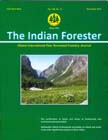Organic Carbon Storage by Ailanthus excelsa Plantations
DOI:
https://doi.org/10.36808/if/2012/v138i11/28666Keywords:
Ailanthus, Carbon Sequestration, Above Ground Biomass, Below Ground BiomassAbstract
This study is related to working out the carbon storage potential of the fast growing species like the Ailanthus excelsa. It is seen that the carbon storage in different tree components, litter and soil increases with the increase in age of the plantation. The carbon concentration in different parts of the tree for all aged plantation followed the decreasing order as stem > root > branch > leaf. The carbon content of litter is estimated and it is found that the lowest return is from the youngest and highest return is from the oldest stand and it indicated a direct relationship with age. The carbon content is estimated using two methods, one is by calculating the biomass and carbon content per cent (formula method) and the other by assumption method. The results show that the assumption method leads to an over-estimation of carbon content for the total organic carbon of the same age when compared to the formula method (especially for younger aged plantations). Therefore, it could be suggested that the assumption method should be avoided for younger age plantations and its use must be restricted only to the older plantations.Downloads
Download data is not yet available.
Downloads
Published
2012-11-01
How to Cite
, Y.- ulman, & Avudainayagam, S. (2012). Organic Carbon Storage by <I>Ailanthus excelsa</I> Plantations. Indian Forester, 138(11), 1041–1046. https://doi.org/10.36808/if/2012/v138i11/28666
Issue
Section
Articles
License
Unless otherwise stated, copyright or similar rights in all materials presented on the site, including graphical images, are owned by Indian Forester.





